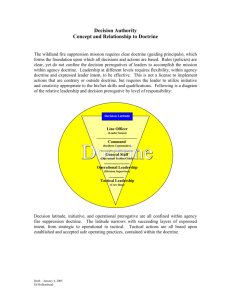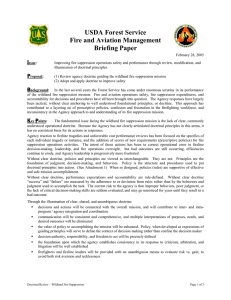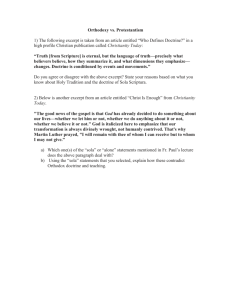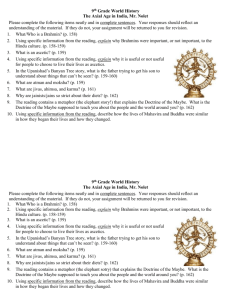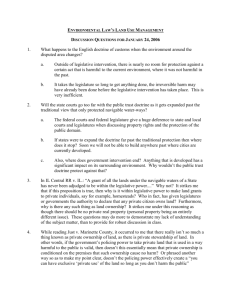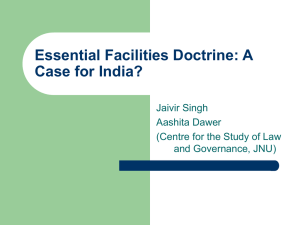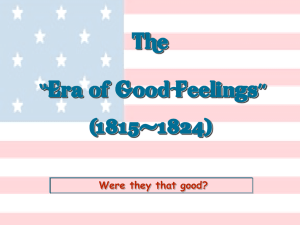Nothing that prohibits intent & empowerment to
advertisement
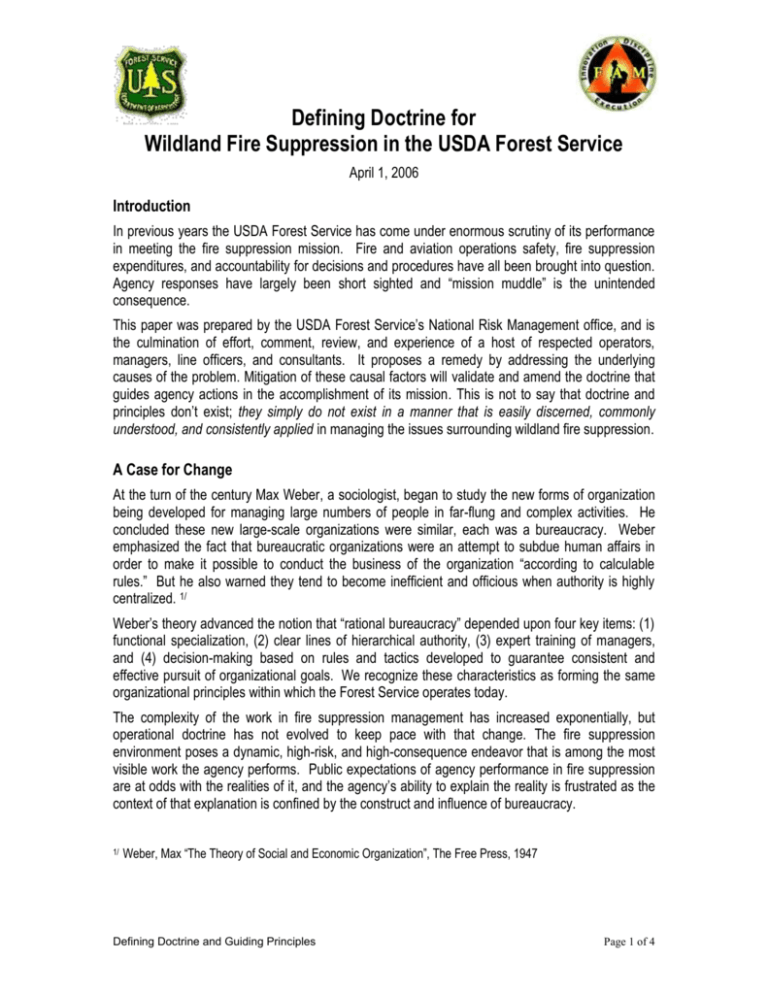
Defining Doctrine for Wildland Fire Suppression in the USDA Forest Service April 1, 2006 Introduction In previous years the USDA Forest Service has come under enormous scrutiny of its performance in meeting the fire suppression mission. Fire and aviation operations safety, fire suppression expenditures, and accountability for decisions and procedures have all been brought into question. Agency responses have largely been short sighted and “mission muddle” is the unintended consequence. This paper was prepared by the USDA Forest Service’s National Risk Management office, and is the culmination of effort, comment, review, and experience of a host of respected operators, managers, line officers, and consultants. It proposes a remedy by addressing the underlying causes of the problem. Mitigation of these causal factors will validate and amend the doctrine that guides agency actions in the accomplishment of its mission. This is not to say that doctrine and principles don’t exist; they simply do not exist in a manner that is easily discerned, commonly understood, and consistently applied in managing the issues surrounding wildland fire suppression. A Case for Change At the turn of the century Max Weber, a sociologist, began to study the new forms of organization being developed for managing large numbers of people in far-flung and complex activities. He concluded these new large-scale organizations were similar, each was a bureaucracy. Weber emphasized the fact that bureaucratic organizations were an attempt to subdue human affairs in order to make it possible to conduct the business of the organization “according to calculable rules.” But he also warned they tend to become inefficient and officious when authority is highly centralized. 1/ Weber’s theory advanced the notion that “rational bureaucracy” depended upon four key items: (1) functional specialization, (2) clear lines of hierarchical authority, (3) expert training of managers, and (4) decision-making based on rules and tactics developed to guarantee consistent and effective pursuit of organizational goals. We recognize these characteristics as forming the same organizational principles within which the Forest Service operates today. The complexity of the work in fire suppression management has increased exponentially, but operational doctrine has not evolved to keep pace with that change. The fire suppression environment poses a dynamic, high-risk, and high-consequence endeavor that is among the most visible work the agency performs. Public expectations of agency performance in fire suppression are at odds with the realities of it, and the agency’s ability to explain the reality is frustrated as the context of that explanation is confined by the construct and influence of bureaucracy. 1/ Weber, Max “The Theory of Social and Economic Organization”, The Free Press, 1947 Defining Doctrine and Guiding Principles Page 1 of 4 A Case for Self-Examination Common perception is that command flows down and results in control of on-the-ground operations, even in highly chaotic environments. When in reality control of on-the-ground operations is in the hands of the ground forces, and fed up to command. Operating within this perception leads managers to assume that negative outcomes may be avoided by asserting more control, by establishing more rules, or by withdrawing from risk. Effective command relies on the expression of clear intent, confidence in subordinate capabilities, acceptance of mutual responsibilities, a specified objective, and freedom to act… all firmly rooted in shared and understood doctrinal principles. Within a rules-based organization “success” and “failure” are measured by the adherence to or deviation from rules. The only real measurement of success in a rules-based system is primarily the absence of bad outcomes (failure), and secondarily the perception of compliance within the rank and file. Those that “succeed” in the rules-based organization are driven by process rather than product. It becomes form over function. Highly prescriptive management environments breed this kind of thinking, mission focus is lost, and the organization is vulnerable to becoming irrelevant. The absence of failure is impossible in a high risk environment, consequently when bad things happen more rules get made – an impossible cycle. The environment and the mission require agility in decision-making, but in time, as the operator’s ability to adapt and react to them becomes more and more constrained by new rules, the probability of “failure” increases proportionally. A consequence of the proliferation of policy following the South Canyon and Thirtymile fires has been the perception of “risk aversion” as a means of avoiding failure. Examples abound across the west where initial action was inappropriately timid, and resulted in larger fires and increased exposure to a far greater number of firefighters. There are spin-off consequences of this behavior: larger fires and higher suppression costs, strained relationships with cooperators, and an unwritten acceptance of risk avoidance. Risk aversion is not complimentary to the agency mission in fire suppression, yet there is currently reward for those that practice it. An organization focused on accomplishing a worthy mission within clearly articulated doctrine and principles is agile, effective, and enduring. Realistic Core Values Desires are often expressed as core values. “All firefighters have the right to a safe assignment.” “Firefighter and public safety is our first priority.” “The Standard Firefighting Orders are firm. We don’t break them, we don’t bend them.” These statements express our sentiments, our desires, but have little to do with accomplishing the agency’s legally mandated mission of fire protection. Core values represent the reality of the work, the environment, and the intention of the agency to meet its mission within that environment. Defining Doctrine and Guiding Principles Page 2 of 4 The purpose and need for the Forest Service in earlier days were simpler and easily defined. Over time the mission, physical, and political environments changed and increased in complexity, but there was little effort to validate and modify the foundational principles (our doctrine) to keep pace. The layering of prescriptive policy, checklists, and a variety of “dos” and “don’ts” have done little to validate the doctrine that guided Forest Service fire suppression management, while leaving it more vulnerable to outside scrutiny and challenge with no defense left to the agency when a checklist was “violated.” Current doctrine is muddled, rather than explicit. It is found in any number of guides, manuals, and handbooks: IRPG, Red-Book, FSM 5130, FSH 5109.17, Fireline Handbook… and the list goes on. Ask any firefighter, fire program leader, or line officer what the doctrinal principles are that guide fire suppression activities, and one will get as many answers as people asked. Well developed doctrine allows us to reclaim “professional judgment” as a legal basis to defend our actions, to reestablish our relevance as a contributor to the quality of American life, and to be consistently better prepared to meet the challenges of change. The Framework Doctrinal principles of wildland fire suppression are based on well defined values of the agency, and turn assumptions of what those agency values are into facts. From the principles will come the strategies and tactics, the tools and techniques for executing them, and define the behaviors that we expect. If we separate doctrine from policy, we’ll be held accountable for policy, but the realm of doctrine will be defendable by professional judgment; “How did you use doctrine to arrive at your decision?”, and “How was your decision consistent with the leader’s expressed intent?” Historical examples will be used to test new doctrine in a risk free environment and explore how our response to accidents might have been different. (i.e. Agency response to Thirtymile created unintended risk aversion. What would be different before, during, or after such a tragedy?) End State Forest Service FAM is an organization guided by well stated doctrinal principles, which represent the reality of the work, the environment, and the mission. They are understood and meaningful to every employee and the public at large, and are the heart of safe and effective mission accomplishment. The effort may spawn interagency interest in comparing and contrasting individual agency doctrine to find the overlap… which then forms the basis for true interagency operating doctrine. Defining Doctrine and Guiding Principles Page 3 of 4 USDA Forest Service Fire Suppression Operations Doctrine Template Mission The Legal Agency Mandate Doctrine Principles is the body of principles that guides the actions of the organization are the foundation of judgment, decisionmaking, and behaviors Policy is the structure and procedures used to put doctrinal principles into action Tools and Techniques Performance Expectations Measures of Success Defining Doctrine and Guiding Principles Page 4 of 4

